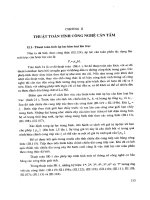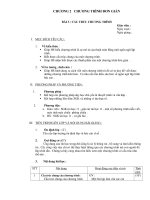Chương 2
Bạn đang xem bản rút gọn của tài liệu. Xem và tải ngay bản đầy đủ của tài liệu tại đây (4.58 MB, 120 trang )
<span class="text_page_counter">Trang 2</span><div class="page_container" data-page="2">
<b> Cơ bản về mạng</b>
</div><span class="text_page_counter">Trang 3</span><div class="page_container" data-page="3"><b>What Is a Network?</b>
<small>A network is a connected collection of devices that can </small>
<small>communicate with each other. Networks carry data in many kinds of environments, including homes, small businesses, and large enterprises. </small>
</div><span class="text_page_counter">Trang 4</span><div class="page_container" data-page="4"><b>Common Physical </b>
<b>Components of a Network</b>
</div><span class="text_page_counter">Trang 5</span><div class="page_container" data-page="5"><b>Interpreting a Network Diagram</b>
</div><span class="text_page_counter">Trang 6</span><div class="page_container" data-page="6"><b>Resource-Sharing Functions and Benefits</b>
<small></small> <b><small>Data and applications</small></b>
</div><span class="text_page_counter">Trang 7</span><div class="page_container" data-page="7"><b>Network User Applications</b>
<small></small> <b><small>Web browser (IE, Firefox, and so on)</small></b>
<small></small> <b><small>Instant messaging (Yahoo IM, Microsoft Messenger, and so on) </small></b>
<small></small> <b><small>Collaboration (Whiteboard, Netmeeting, WebEx, and so on)</small></b>
<small></small> <b><small>Databases (file servers)</small></b>
</div><span class="text_page_counter">Trang 8</span><div class="page_container" data-page="8"><b>Impact of User Applications on the Network</b>
<small></small> <b><small>Batch applications </small></b>
<small></small> <b><small>FTP, TFTP, inventory updates</small></b>
<small></small> <b><small>No direct human interaction</small></b>
<small></small> <b><small>Bandwidth important, but not critical</small></b>
</div><span class="text_page_counter">Trang 10</span><div class="page_container" data-page="10"><b>Physical Topology Categories</b>
</div><span class="text_page_counter">Trang 11</span><div class="page_container" data-page="11"><b>Logical Topologies</b>
</div><span class="text_page_counter">Trang 12</span><div class="page_container" data-page="12"><b>Bus Topology</b>
<small></small><b><small>All devices receive the signal.</small></b>
</div><span class="text_page_counter">Trang 13</span><div class="page_container" data-page="13"><b>Star Topology</b>
<small></small><b><small>Transmission through a central point.</small></b>
<small></small><b><small>Single point of failure.</small></b>
</div><span class="text_page_counter">Trang 14</span><div class="page_container" data-page="14"><b>Extended-Star Topology</b>
<small></small><b><small>More resilient than star topology.</small></b>
</div><span class="text_page_counter">Trang 15</span><div class="page_container" data-page="15"><b>Ring Topology</b>
<small></small><b><small>Signals travel around ring.</small></b>
<small></small><b><small>Single point of failure.</small></b>
</div><span class="text_page_counter">Trang 16</span><div class="page_container" data-page="16"><b>Dual-Ring Topology</b>
<small></small><b><small>Signals travel in opposite directions.</small></b>
<small></small><b><small>More resilient than single ring.</small></b>
</div><span class="text_page_counter">Trang 17</span><div class="page_container" data-page="17"><b>Full-Mesh Topology</b>
<small></small><b><small>Highly fault-tolerant</small></b>
</div><span class="text_page_counter">Trang 18</span><div class="page_container" data-page="18"><b>Partial-Mesh Topology</b>
<small></small><b><small>Trade-off between fault tolerance and cost</small></b>
</div><span class="text_page_counter">Trang 19</span><div class="page_container" data-page="19"><b>Connection to the Internet</b>
</div><span class="text_page_counter">Trang 20</span><div class="page_container" data-page="20"><b>Local Area Network</b>
</div><span class="text_page_counter">Trang 23</span><div class="page_container" data-page="23"><b>LAN Sizes</b>
</div><span class="text_page_counter">Trang 24</span><div class="page_container" data-page="24"><b>2.1. Giới thiệu về mạng Ethernet.</b>
<b><small>started a project, called Project 802, to set</small></b>
<small>standards to enable intercommunication among equipment from a variety of </small>
<small>manufacturers. Project 802 does not seek to replace any part of the OSI or the Internet model. Instead, it is a way of specifying </small>
<small>functions of the physical layer and the data </small>
</div><span class="text_page_counter">Trang 25</span><div class="page_container" data-page="25"><b>2.1. Giới thiệu về mạng Ethernet.</b>
<b><small>into two sublayers: logical link control</small></b>
<b><small>(LLC) and media access control (MAC).</small></b>
<small>IEEE has also created several physical layerstandards for different LAN protocols.</small>
<small>25</small>
</div><span class="text_page_counter">Trang 26</span><div class="page_container" data-page="26"><b>2.1. Giới thiệu về mạng Ethernet.</b>
<small>traditional OSI model</small>
</div><span class="text_page_counter">Trang 27</span><div class="page_container" data-page="27"><b>LAN Standards</b>
<small>2.1. Giới thiệu về mạng Ethernet.</small>
</div><span class="text_page_counter">Trang 28</span><div class="page_container" data-page="28"><b>2.1. Giới thiệu về mạng Ethernet.</b>
<small></small> <b><small>Data Link Layer:</small></b>
<i><b><small>1)Logical Link Control (LLC) :</small></b></i>
<small>In IEEE Project 802, flow control, error control, and part ofthe framing duties are collected into one sublayer called the</small>
<b><small>logical link control .</small></b>
<small>The LLC provides one single data link control protocol for allIEEE LANs.</small>
<small>A single LLC protocol can provide interconncctivity betweendifferent LANs because it makes the MAC sublayertransparent.</small>
<small>The purpose of the LLC is to provide flow and error controlfor the upper layer protocols that actually demand these</small>
</div><span class="text_page_counter">Trang 29</span><div class="page_container" data-page="29"><b>2.1. Giới thiệu về mạng Ethernet.</b>
<i><small>2)Media Access Control (MAC)</small></i><b><small>:</small></b>
<i><small>802.3 MAC frame</small></i>
</div><span class="text_page_counter">Trang 30</span><div class="page_container" data-page="30"><b>2.1. Giới thiệu về mạng Ethernet.</b>
<small>IEEE Project 802 has created a sublayer called</small>
<small>media access control that defines the specific access method for each LAN. </small>
<small>For example, it defines CSMA/CD as the media access method for Ethernet LANs and the token passing method for Token Ring and Token Bus LANs. </small>
<small>In contrast to the LLC sublayer, the MAC sublayer contains a number of distinct modules; each defines the access method and the framing format specific to the corresponding LAN protocol.</small>
</div><span class="text_page_counter">Trang 31</span><div class="page_container" data-page="31"><b>MAC Address Components</b>
</div><span class="text_page_counter">Trang 32</span><div class="page_container" data-page="32"><b>2.1. Giới thiệu về mạng Ethernet.</b>
<small>MAC addresses:</small>
</div><span class="text_page_counter">Trang 33</span><div class="page_container" data-page="33"><b>2.1. Giới thiệu về mạng Ethernet.</b>
<small>on the implementation and type of physical</small>
<small>specifications for each LAN implementation.</small>
<small>33</small>
</div><span class="text_page_counter">Trang 34</span><div class="page_container" data-page="34"><b>2.1. Giới thiệu về mạng Ethernet.</b>
<small>b) Ethernet:</small>
<small>The original Ethernet was created in 1976 atXerox's Palo Alto Research Center (PARC).Since then, it has gone through four generations:Standard Ethemet (10 Mbps), Fast Ethemet (100Mbps), Gigabit Ethemet (1 Gbps), and TenGigabit Ethemet (10 Gbps).</small>
</div><span class="text_page_counter">Trang 35</span><div class="page_container" data-page="35"><b>Ethernet Evolution</b>
<b>2.1. Giới thiệu về mạng Ethernet.</b>
</div><span class="text_page_counter">Trang 36</span><div class="page_container" data-page="36"><b>CSMA/CD</b>
</div><span class="text_page_counter">Trang 37</span><div class="page_container" data-page="37"><b>Ethernet Frame Structure</b>
</div><span class="text_page_counter">Trang 38</span><div class="page_container" data-page="38"><b>Communicating Within the LAN</b>
</div><span class="text_page_counter">Trang 39</span><div class="page_container" data-page="39"><b>2.1. Giới thiệu về mạng Ethernet.</b>
<i><small>Ethernet evolution through four generations</small></i>
</div><span class="text_page_counter">Trang 40</span><div class="page_container" data-page="40"><b>2.1. Giới thiệu về mạng Ethernet.</b>
<i><b><small>1) Standard Ethernet :</small></b></i>
</div><span class="text_page_counter">Trang 41</span><div class="page_container" data-page="41"><b>2.1. Giới thiệu về mạng Ethernet.</b>
<i><b><small>-</small></b><small>Frame Format</small></i> <b><small>:</small></b>
<small>41</small>
</div><span class="text_page_counter">Trang 42</span><div class="page_container" data-page="42"><b>2.1. Giới thiệu về mạng Ethernet.</b>
<i><b><small>-</small></b><small>Frame Length</small></i> <b><small>:</small></b>
</div><span class="text_page_counter">Trang 43</span><div class="page_container" data-page="43"><b>2.1. Giới thiệu về mạng Ethernet.</b>
<i><b><small>-</small></b><small>Addressing</small></i> <b><small>:</small></b> <small>Each station on an Ethernet network (such as aPC, workstation, or printer) has its own network interface card(NIC). The NIC fits inside the station and provides the stationwith a 6-byte physical address.</small>
<i><small>Example of an Ethernet address in hexadecimal notation:</small></i>
</div><span class="text_page_counter">Trang 44</span><div class="page_container" data-page="44"><b>2.1. Giới thiệu về mạng Ethernet.</b>
<small>Unicast, Multicast, and Broadcast Addresses: Asource address is always a unicast address-theframe comes from only one station. Thedestination address, however, can be unicast,multicast, or broadcast.</small>
</div><span class="text_page_counter">Trang 45</span><div class="page_container" data-page="45"><b>2.1. Giới thiệu về mạng Ethernet.</b>
<b><small>-</small></b> <i><small>Access Method: CSMA/CD</small></i>
<small>45</small>
</div><span class="text_page_counter">Trang 46</span><div class="page_container" data-page="46"><b>2.1. Giới thiệu về mạng Ethernet.</b>
</div><span class="text_page_counter">Trang 47</span><div class="page_container" data-page="47"><b>2.1. Giới thiệu về mạng Ethernet.</b>
<small></small> <i><b><small>Encoding in a Standard Ethernet implementation:</small></b></i>
<small>47</small>
</div><span class="text_page_counter">Trang 48</span><div class="page_container" data-page="48"><b>2.1. Giới thiệu về mạng Ethernet.</b>
<b><small>2)Fast Ethernet</small></b>
<small>The goals of Fast Ethemet can be summarized:</small>
<small>Upgrade the data rate to 100 Mbps.</small>
<small>Make it compatible with Standard Ethernet.</small>
<small>Keep the same 48-bit address.</small>
<small>Keep the same frame format.</small>
<small>Keep the same minimum and maximum frame lengths.</small>
</div><span class="text_page_counter">Trang 49</span><div class="page_container" data-page="49"><b>2.1. Giới thiệu về mạng Ethernet.</b>
<small></small> <b><small>MAC Sublayer</small></b>
<i><small>-Autonegotiation</small></i><b><small>: is</small></b> <small>a new feature added to Fast</small>
<small>negotiate the mode or data rate of operation</small>
<i><b><small>- Autonegotiation</small></b></i> <small>was designed particularly for thefollowing purposes:</small>
<small>49</small>
</div><span class="text_page_counter">Trang 50</span><div class="page_container" data-page="50"><b>2.1. Giới thiệu về mạng Ethernet.</b>
</div><span class="text_page_counter">Trang 51</span><div class="page_container" data-page="51"><b>2.1. Giới thiệu về mạng Ethernet.</b>
<small></small> <b><small>Physical Layer.</small></b>
<small>-</small> <i><small>Topology</small></i> <b><small>:</small></b>
<small>51</small>
</div><span class="text_page_counter">Trang 52</span><div class="page_container" data-page="52"><b>2.1. Giới thiệu về mạng Ethernet.</b>
<i><b><small>-Implementation</small></b></i>
</div><span class="text_page_counter">Trang 53</span><div class="page_container" data-page="53"><b>2.1. Giới thiệu về mạng Ethernet.</b>
<small>53</small>
</div><span class="text_page_counter">Trang 54</span><div class="page_container" data-page="54"><b>2.1. Giới thiệu về mạng Ethernet.</b>
<b><small>3) Gigabit Ethernet</small></b>
<small>The goals of the Gigabit Ethernet design can be summarized as follows:</small>
<small>Upgrade the data rate to 1 Gbps.</small>
<small>Make it comoatible with Standard or Fast Ethernet.</small>
<small>Use the same 48-bit address.</small>
<small>Use the same frame format.</small>
<small>Keep the same minimum and maximum frame lengths.</small>
<small>To support autonegotiation as defined in Fast Ethernet</small>
</div><span class="text_page_counter">Trang 55</span><div class="page_container" data-page="55"><b>2.1. Giới thiệu về mạng Ethernet.</b>
<small>The maximum length of the cable is determined bythe signal attenuation in the cable</small>
</div><span class="text_page_counter">Trang 56</span><div class="page_container" data-page="56"><b>2.1. Giới thiệu về mạng Ethernet.</b>
<small>The half-duplex approach uses CSMA/CD.</small>
<small>The maximum length of the network in this approach is totallydependent on the minimum frame size. Three methods havebeen defined: traditional, carrier extension, and framebursting</small>
</div><span class="text_page_counter">Trang 57</span><div class="page_container" data-page="57"><b>2.1. Giới thiệu về mạng Ethernet.</b>
<small></small> <b><small>Physical Layer</small></b>
<small>57</small>
</div><span class="text_page_counter">Trang 58</span><div class="page_container" data-page="58"><b>2.1. Giới thiệu về mạng Ethernet.</b>
<i><b><small>-Implementation</small></b></i>
</div><span class="text_page_counter">Trang 59</span><div class="page_container" data-page="59"><b>2.1. Giới thiệu về mạng Ethernet.</b>
<small>59</small>
</div><span class="text_page_counter">Trang 60</span><div class="page_container" data-page="60"><b>2.2. Kết nối mạng cục bộEthernet.</b>
<small></small> <b><small>Connecting devices</small></b>
<i><small>Five categories of connecting devices</small></i>
</div><span class="text_page_counter">Trang 61</span><div class="page_container" data-page="61"><b>2.2. Kết nối mạng cục bộEthernet.</b>
<small>-Passive hub is just a connector.</small>
<small>-Passive hub connects the wires coming from differentbranches.</small>
<small>- In a star-topology Ethemet LAN, a passive hub is just apoint where the signals coming from different stationscollide; the hub is the collision point. This type of a hub ispart of the media; its location in the Internet model is belowthe physical layer.</small>
<small>61</small>
</div><span class="text_page_counter">Trang 62</span><div class="page_container" data-page="62"><b>2.2. Kết nối mạng cục bộEthernet.</b>
</div><span class="text_page_counter">Trang 63</span><div class="page_container" data-page="63"><b>2.2. Kết nối mạng cục bộEthernet.</b>
<small>-A repeater is a device that operates only in the physicallayer.</small>
<small>-Signals that carry information within a network can travel afixed distance before attenuation endangers the integrity ofthe data.</small>
<small>-A repeater connects segments of a LAN</small>
<small>63</small>
</div><span class="text_page_counter">Trang 64</span><div class="page_container" data-page="64"><b>2.2. Kết nối mạng cục bộEthernet.</b>
</div><span class="text_page_counter">Trang 65</span><div class="page_container" data-page="65"><b>2.2. Kết nối mạng cục bộEthernet.</b>
<small>repeater. It is normally used to create connectionsbetween stations in a physical star topology. Hubs canalso be used to create multiple levels of hierarchy</small>
<small>65</small>
</div><span class="text_page_counter">Trang 66</span><div class="page_container" data-page="66"><b>2.2. Kết nối mạng cục bộEthernet.</b>
<small>link layer.</small>
<small>addresses in a frame</small>
</div><span class="text_page_counter">Trang 67</span><div class="page_container" data-page="67"><b>2.2. Kết nối mạng cục bộEthernet.</b>
<i><small>A bridge connecting two LANs</small></i>
</div><span class="text_page_counter">Trang 68</span><div class="page_container" data-page="68"><b>2.2. Kết nối mạng cục bộEthernet.</b>
<small></small> <b><small>Routers</small></b>
<b><small>A router is a three-layer device that routes packets</small></b>
<small>based on their logical addresses (host-to-hostaddressing). A router normally connects LANs andWANs in the Internet and has a routing table that isused for making decisions about the route. Therouting tables are normally dynamic and are updatedusing routing protocols</small>
</div><span class="text_page_counter">Trang 69</span><div class="page_container" data-page="69"><b>2.2. Kết nối mạng cục bộEthernet.</b>
<i><small>Routers connecting independent LANs and WANs</small></i>
</div><span class="text_page_counter">Trang 70</span><div class="page_container" data-page="70"><b>2.2. Kết nối mạng cục bộEthernet.</b>
<small></small> <b><small>Gateway</small></b>
<small>A gateway is normally a computer that operates in all fivelayers of the Internet or seven layers of OSI model. Agateway takes an application message, reads it, andinterprets it. This means that it can be used as a connectingdevice between two internetworks that use different models.For example, a network designed to use the OSI model canbe connected to another network using the Internet model.The gateway connecting the two systems can take a frame asit arrives from the first system, move it up to the OSIapplication layer, and remove the message</small>
</div><span class="text_page_counter">Trang 71</span><div class="page_container" data-page="71"><b>2.2. Kết nối mạng cục bộEthernet.</b>
</div><span class="text_page_counter">Trang 72</span><div class="page_container" data-page="72"><b>2.2. Kết nối mạng cục bộEthernet.</b>
<small>Operate at Layer 2 of the OSI model</small>
<small>Forward, filter, or flood frames</small>
<small>Have few ports</small>
<small></small>
</div><span class="text_page_counter">Trang 73</span><div class="page_container" data-page="73"><b>2.2. Kết nối mạng cục bộEthernet.</b>
<b><small>LAN Switch</small></b>
<small>High port density</small>
<small>Large frame buffers</small>
<small>Mixture of port speeds</small>
<small>Fast internal switching</small>
<small>Switching modes:</small>
<small>–Fragment-free</small>
</div><span class="text_page_counter">Trang 74</span><div class="page_container" data-page="74"><b>2.2. Kết nối mạng cục bộEthernet.</b>
<small>Transmitting Frames through a Switch</small>
</div><span class="text_page_counter">Trang 75</span><div class="page_container" data-page="75"><b>2.2. Kết nối mạng cục bộEthernet.</b>
</div><span class="text_page_counter">Trang 76</span><div class="page_container" data-page="76"><b>2.2. Kết nối mạng cục bộEthernet.</b>
<b><small>How Switches Learn Host Locations</small></b>
</div><span class="text_page_counter">Trang 77</span><div class="page_container" data-page="77"><b>2.2. Kết nối mạng cục bộEthernet.</b>
<small>•Station A sends a frame to Station C</small>
<small>•Switch caches station A MAC address to port E0 by learning the source address of data frames </small>
<small>•The frame from station A to station C is flooded out to all ports except port E0 (unknown unicasts are flooded)</small>
</div><span class="text_page_counter">Trang 78</span><div class="page_container" data-page="78"><b>2.2. Kết nối mạng cục bộEthernet.</b>
<small>•Station D sends a frame to station C</small>
<small>•Switch caches station D MAC address to port E3 by learning the source Address of data frames</small>
<small>•The frame from station D to station C is flooded out to all ports except port E3 (unknown unicasts are flooded)</small>
</div><span class="text_page_counter">Trang 79</span><div class="page_container" data-page="79"><b>2.2. Kết nối mạng cục bộEthernet.</b>
<b><small>How Switches Filter Frames</small></b>
<small>•</small> <b><small>Station A sends a frame to station C</small></b>
<small>•</small> <b><small>Destination is known, frame is not flooded </small></b>
</div><span class="text_page_counter">Trang 80</span><div class="page_container" data-page="80"><b>2.2. Kết nối mạng cục bộEthernet.</b>
<b><small>Broadcast and Multicast Frames</small></b>
<small>•Station D sends a broadcast or multicast frame</small>
<small>•Broadcast and multicast frames are flooded to all ports other than the originating port</small>
</div><span class="text_page_counter">Trang 81</span><div class="page_container" data-page="81"><b>2.2. Kết nối mạng cục bộEthernet.</b>
<b><small>Loops</small></b>
</div><span class="text_page_counter">Trang 82</span><div class="page_container" data-page="82"><b>2.2. Kết nối mạng cục bộEthernet.</b>
<b><small>Spanning tree protocol</small></b>
</div><span class="text_page_counter">Trang 83</span><div class="page_container" data-page="83"><b><small>2.4. Q trình phân phối gói tin từ host to host thông qua switch</small></b>
<small>83</small>
</div><span class="text_page_counter">Trang 85</span><div class="page_container" data-page="85"><b>Layer 2 Addressing</b>
<small></small><b><small>Assigned to end devices</small></b>
</div><span class="text_page_counter">Trang 86</span><div class="page_container" data-page="86"><b>Layer 3 Devices and Their Function</b>
<small></small><b><small>The network layer provides connectivity and path selection between two host systems.</small></b>
<small></small><b><small>In the host, this is the path between the data link layer and the upper layers of the NOS. </small></b>
<small></small><b><small>In the router, it is the actual path across the network. </small></b>
</div><span class="text_page_counter">Trang 87</span><div class="page_container" data-page="87"><b>Layer 3 Addressing</b>
<small></small><b><small>OSI uses NSAP. </small></b>
<small></small><b><small>TCP/IP uses IP. </small></b>
</div><span class="text_page_counter">Trang 88</span><div class="page_container" data-page="88"><b>Host-to-Host Packet Delivery (1 of 10) -UDP</b>
</div><span class="text_page_counter">Trang 89</span><div class="page_container" data-page="89"><b>Host-to-Host Packet Delivery (2 of 10)</b>
</div><span class="text_page_counter">Trang 90</span><div class="page_container" data-page="90"><b>Host-to-Host Packet Delivery (3 of 10)</b>
</div><span class="text_page_counter">Trang 91</span><div class="page_container" data-page="91"><b>Host-to-Host Packet Delivery (4 of 10)</b>
</div><span class="text_page_counter">Trang 92</span><div class="page_container" data-page="92"><b>Host-to-Host Packet Delivery (5 of 10)</b>
</div><span class="text_page_counter">Trang 93</span><div class="page_container" data-page="93"><b>Host-to-Host Packet Delivery (6 of 10)</b>
</div><span class="text_page_counter">Trang 94</span><div class="page_container" data-page="94"><b>Host-to-Host Packet Delivery (7 of 10)</b>
</div><span class="text_page_counter">Trang 95</span><div class="page_container" data-page="95"><b>Host-to-Host Packet Delivery (8 of 10)</b>
</div><span class="text_page_counter">Trang 96</span><div class="page_container" data-page="96"><b>Host-to-Host Packet Delivery (9 of 10)</b>
</div><span class="text_page_counter">Trang 97</span><div class="page_container" data-page="97"><b>Host-to-Host Packet Delivery (10 of 10)</b>
</div><span class="text_page_counter">Trang 98</span><div class="page_container" data-page="98"><b>Host-to-Host Packet Delivery (1 of 22)-TCP</b>
</div><span class="text_page_counter">Trang 99</span><div class="page_container" data-page="99"><b>Host-to-Host Packet Delivery (2 of 22)</b>
</div><span class="text_page_counter">Trang 100</span><div class="page_container" data-page="100"><b>Host-to-Host Packet Delivery (3 of 22)</b>
</div><span class="text_page_counter">Trang 101</span><div class="page_container" data-page="101"><b>Host-to-Host Packet Delivery (4 of 22)</b>
</div><span class="text_page_counter">Trang 102</span><div class="page_container" data-page="102"><b>Host-to-Host Packet Delivery (5 of 22)</b>
</div><span class="text_page_counter">Trang 103</span><div class="page_container" data-page="103"><b>Host-to-Host Packet Delivery (6 of 22)</b>
</div><span class="text_page_counter">Trang 104</span><div class="page_container" data-page="104"><b>Host-to-Host Packet Delivery (7 of 22)</b>
</div><span class="text_page_counter">Trang 105</span><div class="page_container" data-page="105"><b>Host-to-Host Packet Delivery (8 of 22)</b>
</div><span class="text_page_counter">Trang 106</span><div class="page_container" data-page="106"><b>Host-to-Host Packet Delivery (9 of 22)</b>
</div><span class="text_page_counter">Trang 107</span><div class="page_container" data-page="107"><b>Host-to-Host Packet Delivery (10 of 22)</b>
</div><span class="text_page_counter">Trang 108</span><div class="page_container" data-page="108"><b>Host-to-Host Packet Delivery (11 of 22)</b>
</div><span class="text_page_counter">Trang 109</span><div class="page_container" data-page="109"><b>Host-to-Host Packet Delivery (12 of 22)</b>
</div><span class="text_page_counter">Trang 110</span><div class="page_container" data-page="110"><b>Host-to-Host Packet Delivery (13 of 22)</b>
</div><span class="text_page_counter">Trang 111</span><div class="page_container" data-page="111"><b>Host-to-Host Packet Delivery (14 of 22)</b>
</div><span class="text_page_counter">Trang 112</span><div class="page_container" data-page="112"><b>Host-to-Host Packet Delivery (15 of 22)</b>
</div><span class="text_page_counter">Trang 113</span><div class="page_container" data-page="113"><b>Host-to-Host Packet Delivery (16 of 22)</b>
</div><span class="text_page_counter">Trang 114</span><div class="page_container" data-page="114"><b>Host-to-Host Packet Delivery (17 of 22)</b>
</div><span class="text_page_counter">Trang 115</span><div class="page_container" data-page="115"><b>Host-to-Host Packet Delivery (18 of 22)</b>
</div><span class="text_page_counter">Trang 116</span><div class="page_container" data-page="116"><b>Host-to-Host Packet Delivery (19 of 22)</b>
</div><span class="text_page_counter">Trang 117</span><div class="page_container" data-page="117"><b>Host-to-Host Packet Delivery (20 of 22)</b>
</div><span class="text_page_counter">Trang 118</span><div class="page_container" data-page="118"><b>Host-to-Host Packet Delivery (21 of 22)</b>
</div><span class="text_page_counter">Trang 119</span><div class="page_container" data-page="119"><b>Host-to-Host Packet Delivery (22 of 22)</b>
</div><span class="text_page_counter">Trang 120</span><div class="page_container" data-page="120"><b>Default Gateway </b>
</div>








